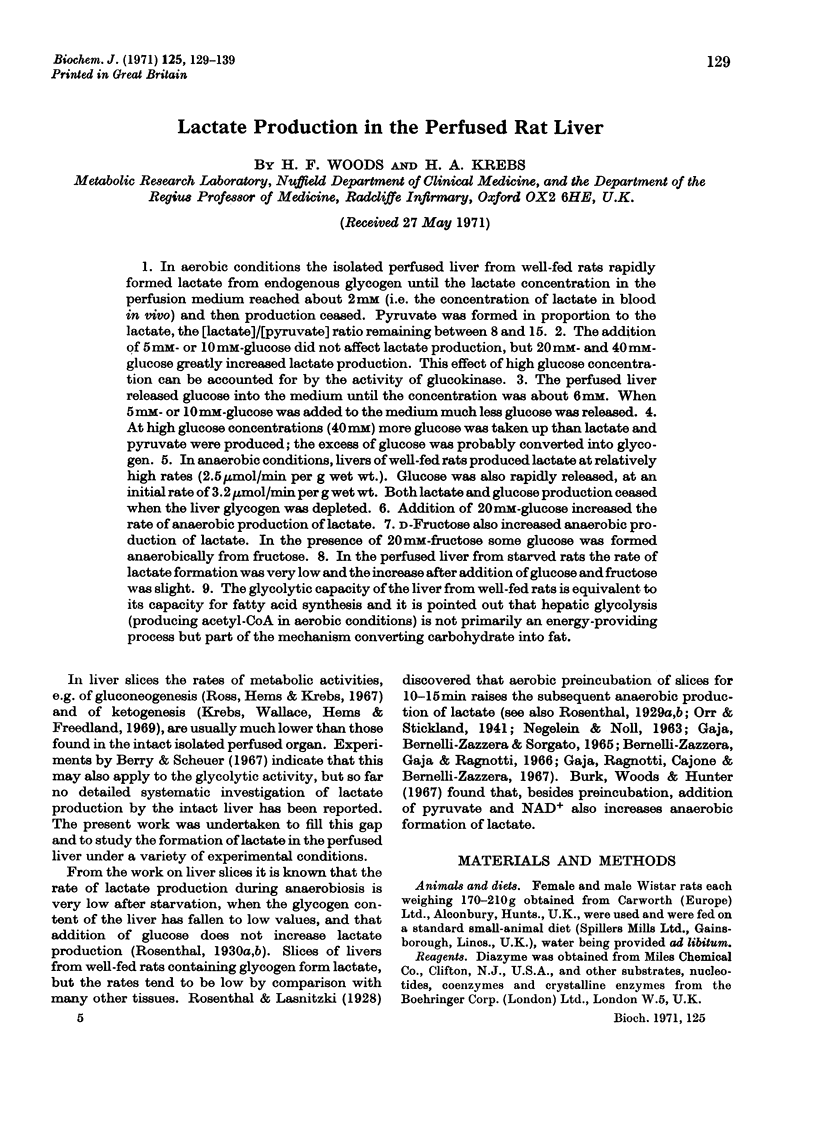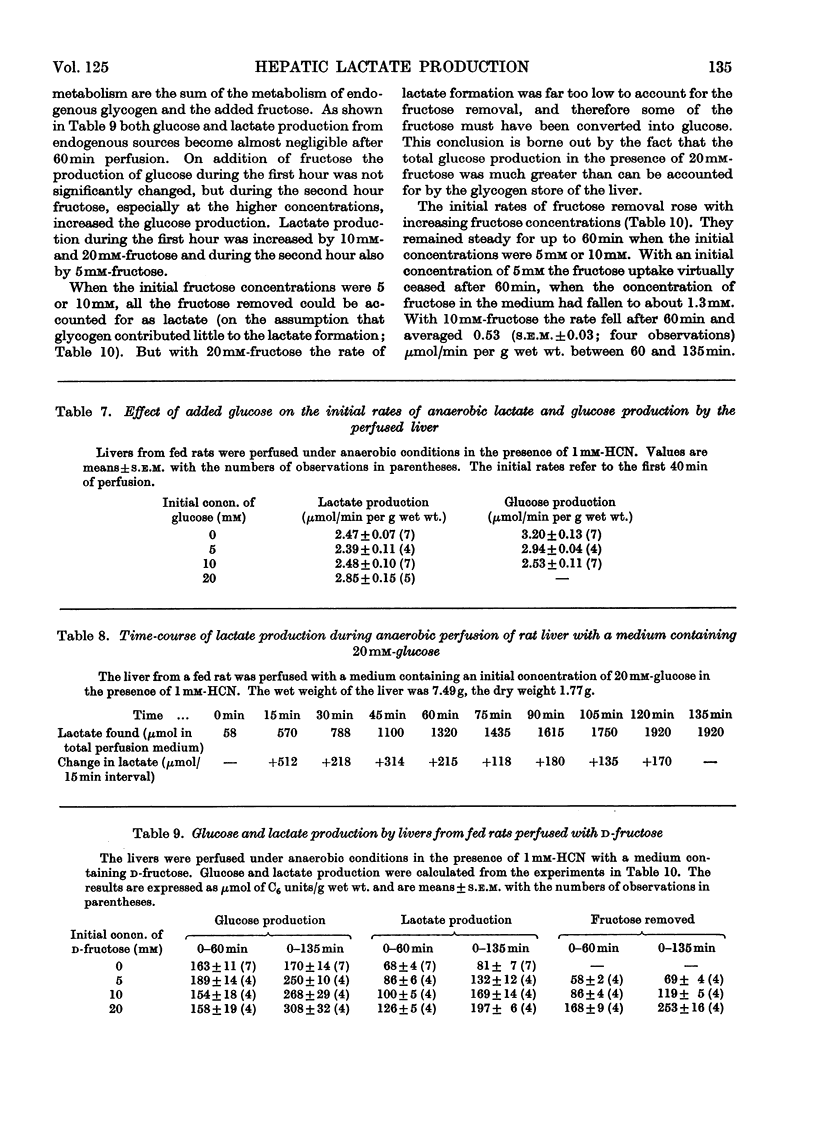Abstract
1. In aerobic conditions the isolated perfused liver from well-fed rats rapidly formed lactate from endogenous glycogen until the lactate concentration in the perfusion medium reached about 2mm (i.e. the concentration of lactate in blood in vivo) and then production ceased. Pyruvate was formed in proportion to the lactate, the [lactate]/[pyruvate] ratio remaining between 8 and 15. 2. The addition of 5mm- or 10mm-glucose did not affect lactate production, but 20mm- and 40mm-glucose greatly increased lactate production. This effect of high glucose concentration can be accounted for by the activity of glucokinase. 3. The perfused liver released glucose into the medium until the concentration was about 6mm. When 5mm- or 10mm-glucose was added to the medium much less glucose was released. 4. At high glucose concentrations (40mm) more glucose was taken up than lactate and pyruvate were produced; the excess of glucose was probably converted into glycogen. 5. In anaerobic conditions, livers of well-fed rats produced lactate at relatively high rates (2.5μmol/min per g wet wt.). Glucose was also rapidly released, at an initial rate of 3.2μmol/min per g wet wt. Both lactate and glucose production ceased when the liver glycogen was depleted. 6. Addition of 20mm-glucose increased the rate of anaerobic production of lactate. 7. d-Fructose also increased anaerobic production of lactate. In the presence of 20mm-fructose some glucose was formed anaerobically from fructose. 8. In the perfused liver from starved rats the rate of lactate formation was very low and the increase after addition of glucose and fructose was slight. 9. The glycolytic capacity of the liver from well-fed rats is equivalent to its capacity for fatty acid synthesis and it is pointed out that hepatic glycolysis (producing acetyl-CoA in aerobic conditions) is not primarily an energy-providing process but part of the mechanism converting carbohydrate into fat.
Full text
PDF










Selected References
These references are in PubMed. This may not be the complete list of references from this article.
- Bernelli-Zazzera A., Gaja G., Ragnotti G. The stimulation of glycolysis by previous aerobiosis in rat-liver slices. Biochem J. 1966 Jul;100(1):114–119. doi: 10.1042/bj1000114. [DOI] [PMC free article] [PubMed] [Google Scholar]
- Burk D., Woods M., Hunter J. On the significance of glucolysis for cancer growth, with special reference to Morris rat hepatomas. J Natl Cancer Inst. 1967 Jun;38(6):839–863. [PubMed] [Google Scholar]
- Dickens F., Greville G. D. The metabolism of normal and tumour tissue: The anaerobic conversion of fructose into lactic acid by tumour and adult normal tissues. Biochem J. 1932;26(5):1546–1556. doi: 10.1042/bj0261546. [DOI] [PMC free article] [PubMed] [Google Scholar]
- FROSANDER O. A., RAEIHAE N., SALASPURO M., MAEENPAEAE P. INFLUENCE OF ETHANOL ON THE LIVER METABOLISM OF FED AND STARVED RATS. Biochem J. 1965 Jan;94:259–265. doi: 10.1042/bj0940259. [DOI] [PMC free article] [PubMed] [Google Scholar]
- Gaja G., Ferrero M. E. The effect of aerobic preincubation on anaerobic glycogenolysis in liver slices. FEBS Lett. 1970 Jan 15;6(1):31–33. doi: 10.1016/0014-5793(70)80034-5. [DOI] [PubMed] [Google Scholar]
- Gaja G., Ragnotti G., Cajone F., Bernelli-Zazzera A. Changes in the concentrations of some phosphorylated intermediates and stimulation of glycolysis in liver slices. Biochem J. 1968 Oct;109(5):867–875. doi: 10.1042/bj1090867. [DOI] [PMC free article] [PubMed] [Google Scholar]
- Gaja G., Ragnotti G., Cajone F., Bernelli-Zazzera A. Further studies on the stimulation of glycolysis by previous aerobiosis. Biochem J. 1967 Nov;105(2):647–654. doi: 10.1042/bj1050647. [DOI] [PMC free article] [PubMed] [Google Scholar]
- Glinsmann W. H., Hern E. P., Lynch A. Intrinsic regulation of glucose output by rat liver. Am J Physiol. 1969 Apr;216(4):698–703. doi: 10.1152/ajplegacy.1969.216.4.698. [DOI] [PubMed] [Google Scholar]
- Heinz F., Lamprecht W., Kirsch J. Enzymes of fructose metabolism in human liver. J Clin Invest. 1968 Aug;47(8):1826–1832. doi: 10.1172/JCI105872. [DOI] [PMC free article] [PubMed] [Google Scholar]
- Hems R., Ross B. D., Berry M. N., Krebs H. A. Gluconeogenesis in the perfused rat liver. Biochem J. 1966 Nov;101(2):284–292. doi: 10.1042/bj1010284. [DOI] [PMC free article] [PubMed] [Google Scholar]
- Kalkhoff R. K., Hornbrook K. R., Burch H. B., Kipnis D. M. Studies of the metabolic effects of acute insulin deficiency. II. Changes in hepatic glycolytic and krebs-cycle intermediates and pyridine nucleotides. Diabetes. 1966 Jul;15(7):451–456. doi: 10.2337/diab.15.7.451. [DOI] [PubMed] [Google Scholar]
- Krebs H. A., Dierks C., Gascoyne T. Carbohydrate synthesis from lactate in pigeon-liver homogenate. Biochem J. 1964 Oct;93(1):112–121. doi: 10.1042/bj0930112. [DOI] [PMC free article] [PubMed] [Google Scholar]
- Krebs H. A., Wallace P. G., Hems R., Freedland R. A. Rates of ketone-body formation in the perfused rat liver. Biochem J. 1969 May;112(5):595–600. doi: 10.1042/bj1120595. [DOI] [PMC free article] [PubMed] [Google Scholar]
- NEGELEIN E., NOLL F. UBER DIE GLYKOLYSE DER LEBER. I. GLYKOLYSE DER NORMALEN LEBER. Biochem Z. 1963;338:728–734. [PubMed] [Google Scholar]
- Orr J. W., Stickland L. H. The metabolism of rat liver during carcinogenesis by butter yellow. Biochem J. 1941 Apr;35(4):479–487. doi: 10.1042/bj0350479. [DOI] [PMC free article] [PubMed] [Google Scholar]
- Otway S., Robinson D. S. The use of a non-ionic detergent (Triton WR 1339) to determine rates of triglyceride entry into the circulation of the rat under different physiological conditions. J Physiol. 1967 May;190(2):321–332. doi: 10.1113/jphysiol.1967.sp008211. [DOI] [PMC free article] [PubMed] [Google Scholar]
- ROBINSON D. S. THE CLEARING FACTOR LIPASE AND ITS ACTION IN THE TRANSPORT OF FATTY ACIDS BETWEEN THE BLOOD AND TISSUES. Adv Lipid Res. 1963;1:133–182. doi: 10.1016/b978-1-4831-9937-5.50010-7. [DOI] [PubMed] [Google Scholar]
- Rawat A. K. Effects of ethanol infusion on the redox state and metabolite levels in rat liver in vivo. Eur J Biochem. 1968 Dec 5;6(4):585–592. doi: 10.1111/j.1432-1033.1968.tb00485.x. [DOI] [PubMed] [Google Scholar]
- Ross B. D., Hems R., Krebs H. A. The rate of gluconeogenesis from various precursors in the perfused rat liver. Biochem J. 1967 Mar;102(3):942–951. doi: 10.1042/bj1020942. [DOI] [PMC free article] [PubMed] [Google Scholar]
- SCHIMASSEK H. Perfusion of isolated rat liver with a semi-synthetic medium and control of liver function. Life Sci. 1962 Nov;1:629–634. doi: 10.1016/0024-3205(62)90096-6. [DOI] [PubMed] [Google Scholar]
- Start C., Newsholme E. A. The effects of starvation and alloxan-diabetes on the contents of citrate and other metabolic intermediates in rat liver. Biochem J. 1968 Apr;107(3):411–415. doi: 10.1042/bj1070411. [DOI] [PMC free article] [PubMed] [Google Scholar]
- Williamson D. H., Veloso D., Ellington E. V., Krebs H. A. Changes in the concentrations of hepatic metabolites on administration of dihydroxyacetone or glycerol to starved rats and their relationship to the control of ketogenesis. Biochem J. 1969 Sep;114(3):575–584. doi: 10.1042/bj1140575. [DOI] [PMC free article] [PubMed] [Google Scholar]
- Woods H. F., Eggleston L. V., Krebs H. A. The cause of hepatic accumulation of fructose 1-phosphate on fructose loading. Biochem J. 1970 Sep;119(3):501–510. doi: 10.1042/bj1190501. [DOI] [PMC free article] [PubMed] [Google Scholar]


